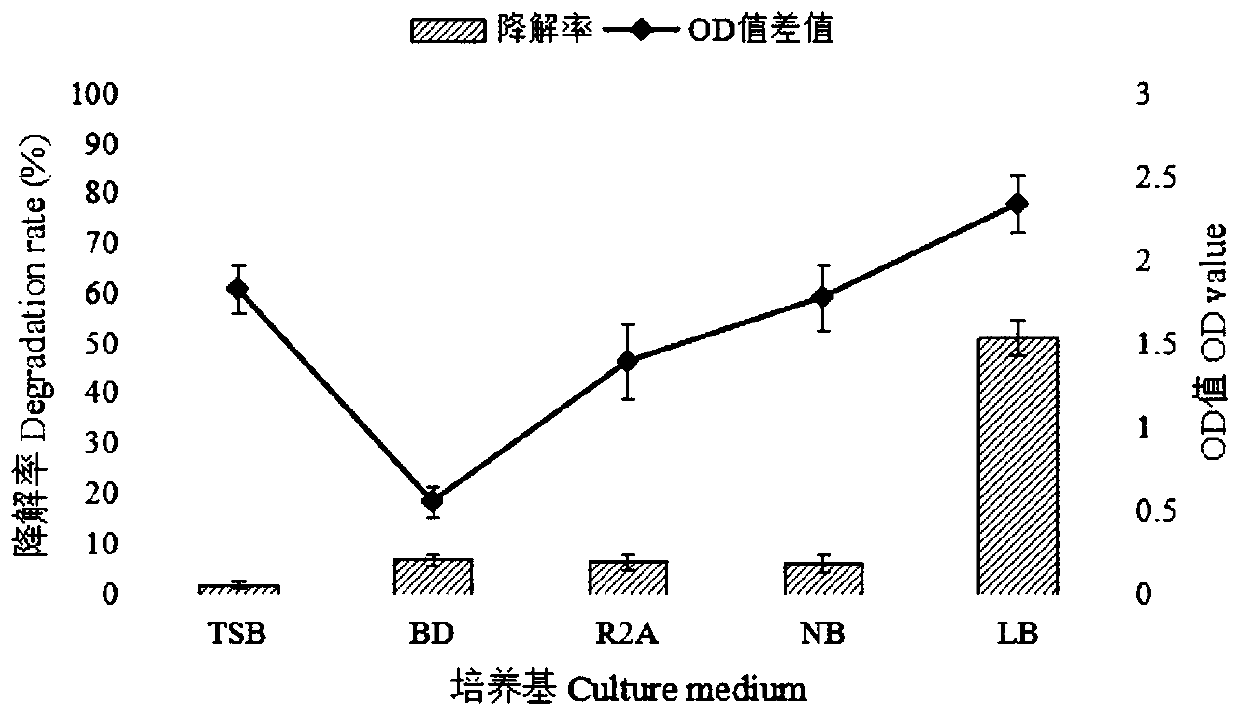Stappia strain and its application in degradation of zearalenone
A technology of zearalenone and Staples genus, applied in the direction of bacteria, microorganism-based methods, microorganisms, etc., can solve the problems of single type of degrading strains, differences in degrading ability of strains, production limitations of key enzymes, etc. Achieve the effect of wide application value, wide growth temperature and easy cultivation
- Summary
- Abstract
- Description
- Claims
- Application Information
AI Technical Summary
Problems solved by technology
Method used
Image
Examples
Embodiment 1
[0028] Embodiment one: Staple's genus ( Stappia sp. ) Isolation, screening and identification of YM29
[0029] (1) Separation and screening:
[0030] The soil samples of plant rhizosphere in Wulabo region of Xinjiang were collected, and microorganisms were isolated and purified by gradient dilution method. Weigh 10g of the soil sample, put it into 100ml of sterile water, add sterilized glass beads, shake at 150rpm, 30°C for 20min, to fully disperse the sample. Aseptically draw supernatant 100μl into 900μl sterile water, dilute with sterile water to make 10 -2 -10 -5 concentrated diluent. Take 100 μl of the dilutions of each concentration, use the conventional coating method in the inorganic salt medium containing 10 μg / mL zearalenone, place it in a constant temperature incubator at 30 ° C for 72 hours, and wait until the colonies grow on the plate. , Pick a single colony on the plate for purification and culture until there are no other colonies. A strain numbered YM29 w...
Embodiment 2
[0047] Embodiment two: different mediums are to Staples ( Stappia sp. ) Effect of YM29 on Degradation of Zearalenone
[0048] Pick the genus Staples ( Stappia sp. ) The fresh bacterial lawn of YM29 was inoculated into LB liquid medium, and cultured on a shaker at 120r / min and 30°C for 24h to obtain seed liquid; the seed liquid was inoculated at 2% in different culture medium containing 10μg / mL zearalenone Medium, 120r / min, 30°C for 120h, the growth and degradation efficiency of the strain YM29 was determined.
[0049] The test results can be found in the appendix figure 2 As shown, the strain YM29 grew best on LB medium, and its zearalenone degradation rate was also the highest, while the strain was also grown on tryptone soy broth (TSB) and nutrient broth (NB). Better, but the degradation rate of zearalenone is lower; the growth and degradation ability of the strain in sea salt broth medium (BD) are poor.
Embodiment 3
[0050] Embodiment three: different cultivation temperature is to Staple's genus ( Stappia sp. ) Effect of YM29 on Degradation of Zearalenone
[0051] Pick the fresh bacterial lawn and inoculate it into the LB liquid medium, culture it on a shaker at 120r / min and 30°C for 24 hours to obtain the seed liquid; inoculate the seed liquid at 2% in LB medium containing 10 μg / mL zearalenone In the medium, at different temperatures, 120r / min, cultured for 120h, the growth and degradation efficiency of strain YM29 were determined.
[0052] The test results can be found in the appendix image 3 As shown, although the strain can grow at all experimental temperatures, it grows better at 30°C−37°C, and the OD value of the bacterial solution is higher. Within 20℃−37℃, the degradation rate was positively correlated with temperature, and the degradation rate gradually decreased with the increase of temperature up to 42℃.
PUM
 Login to View More
Login to View More Abstract
Description
Claims
Application Information
 Login to View More
Login to View More - R&D
- Intellectual Property
- Life Sciences
- Materials
- Tech Scout
- Unparalleled Data Quality
- Higher Quality Content
- 60% Fewer Hallucinations
Browse by: Latest US Patents, China's latest patents, Technical Efficacy Thesaurus, Application Domain, Technology Topic, Popular Technical Reports.
© 2025 PatSnap. All rights reserved.Legal|Privacy policy|Modern Slavery Act Transparency Statement|Sitemap|About US| Contact US: help@patsnap.com



